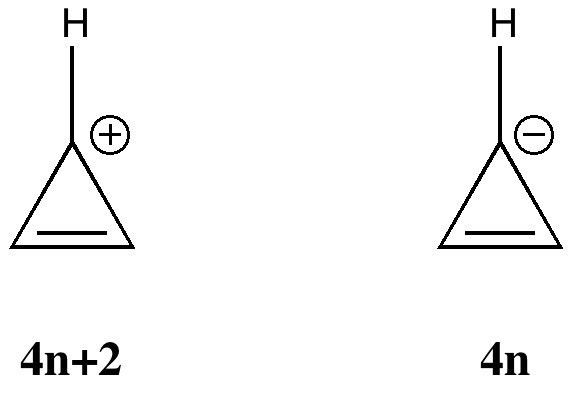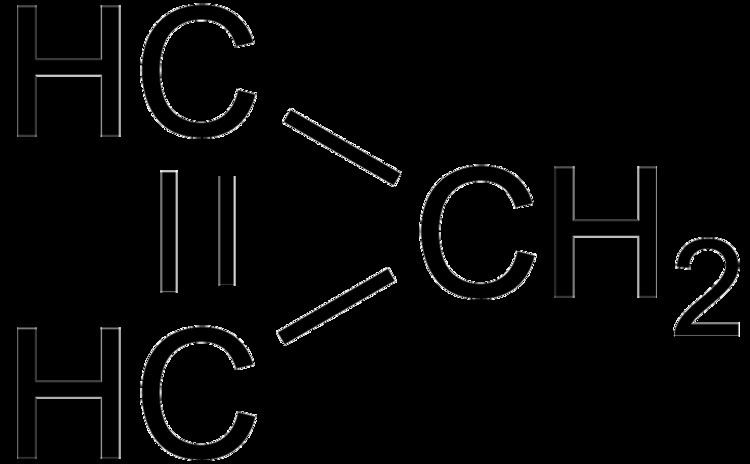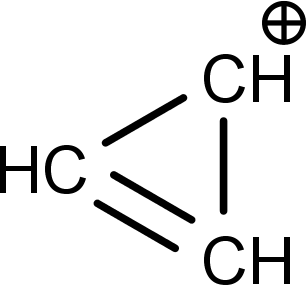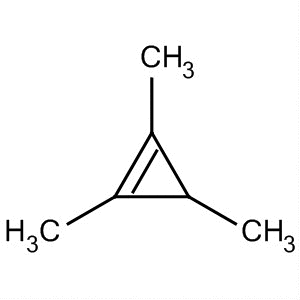Formula C3H4 | ||
 | ||
Cyclopropene is an organic compound with the formula C3H4. It is the simplest cycloalkene. It has a triangular structure. Because the ring is highly strained, cyclopropene is difficult to prepare, and a useful core for studies of bonding and molecular orbitals. The reduced length of the double bond compared to a single bond causes the angle opposite the double bond to narrow to about 51° from the 60° angle found in cyclopropane. As with cyclopropane, the carbon–carbon bonding in the ring has increased p character: the alkene carbons use sp2.68 hybridization for the ring.
Contents
- Early syntheses
- Modern syntheses from allyl chlorides
- Syntheses of derivatives
- Reactions of cyclopropene
- Related compounds
- References

Early syntheses

The first confirmed synthesis of cyclopropene, carried out by Dem'yanov and Doyarenko, involved the thermal decomposition of trimethylcyclopropylammonium hydroxide over platinized clay at 320–330 °C under a CO2 atmosphere. This reaction produces mainly trimethylamine and dimethylcyclopropyl amine, together with about 5% of cyclopropene. Cyclopropene can also be obtained in about 1% yield by thermolysis of the adduct of cycloheptatriene and dimethyl acetylenedicarboxylate.
Modern syntheses from allyl chlorides

Allyl chloride undergoes dehydrohalogenation upon treatment with the base sodium amide at 80 °C to produce cyclopropene in about 10% yield.

The major byproduct of the reaction is allylamine. Adding allyl chloride to sodium bis(trimethylsilyl)amide in boiling toluene over a period of 45–60 minutes produces the targeted compound in about 40% yield with an improvement in purity:
1-Methylcyclopropene is synthesized similarly but at room temperature from methallylchloride using phenyllithium as the base:
Syntheses of derivatives

Treatment of nitrocyclopropanes with sodium methoxide eliminates the nitrite, giving the respective cyclopropene derivative. The synthesis of purely aliphatic cyclopropenes was first illustrated by the copper-catalyzed additions of carbenes to alkynes. In the presence of a copper sulfate catalyst, ethyl diazoacetate reacts with acetylenes to give cyclopropenes. 1,2-Dimethylcyclopropene-3-carboxylate arises via this method from 2-butyne. Copper has proved to be useful as a catalyst in a variety of cyclopropene syntheses. Copper sulfate and copper dust are among the more popular forms of copper used.Recently, Rhodium acetate has been used to synthesize derivatives of cyclopropene at room temperature and in high yields.
Reactions of cyclopropene
Studies on cyclopropene mainly focus on the consequences of its high ring strain. At 425 °C, cyclopropene isomerizes to methylacetylene (propyne).
C3H4 → H3CC≡CHAttempted fractional distillation of cyclopropene at –36 °C (its predicted boiling point) results in polymerization. The mechanism is assumed to be a free-radical chain reaction, and the product, based on NMR spectra, is thought to be polycyclopropane.
Cyclopropene undergoes the Diels–Alder reaction with cyclopentadiene to give endo-tricyclo[3.2.1.02,4]oct-6-ene. This reaction is commonly used to check for the presence of cyclopropene, following its synthesis.
